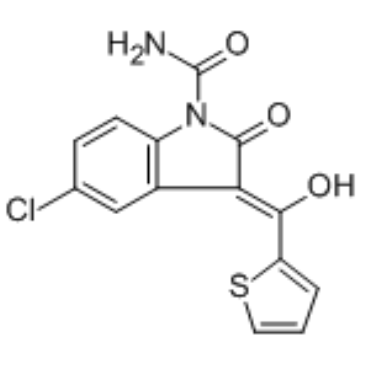Tenidap decreases IL-8 and monocyte chemotactic peptide-1 (MCP-1) mRNA expression in the synovial tissue of rabbits with antigen arthritis and in cultured synovial cells.
I Palacios, M J Lopez-Armada, P Hernandez, O Sanchez-Pernaute, S Gutierrez, R Miguelez, J Martinez, J Egido, G Herrero-Beaumont
Index: Clin. Exp. Immunol. 111(3) , 588-96, (1998)
Full Text: HTML
Abstract
Since IL-8 and MCP-1 are chemoattractant proteins that participate in the recruitment of inflammatory cells into the arthritic joint, we examined the effects of tenidap, a new anti-inflammatory drug of the oxindole family, on IL-8 and MCP-1 expression in the joints of rabbits with acute antigen arthritis. The model was induced by injecting 5 mg/ml ovalbumin into the knees of 20 preimmunized rabbits. Animals were randomized into two groups: treated with tenidap (15 mg/kg per 12 h), or untreated. The effect of tenidap treatment was evaluated on chemokine production in synovial membranes of rabbits with arthritis and in cultured monocytic and synovial cells (SC). By immunoperoxidase staining, chemokines were localized in the synovial tissue. Chemokine messenger RNA levels in the synovial membranes and in cultured cells were analysed by reverse transcription-polymerase chain reaction (RT-PCR). At the end of the study, tenidap significantly reduced neutrophil infiltration into the joint cavity (27+/-4 x 10(6) cells/ml versus 45+/-6 x 10(6) cells/ml in untreated; P<0.05), and synovial effusion (134+/-15 microl versus 236+/-19 microl in untreated; P<0.005). Untreated rabbits showed synovial membrane up-regulation in mRNA expression of IL-8 and MCP-1 (11- and seven-fold versus healthy rabbits, respectively) that was markedly decreased by tenidap (two- and three-fold versus healthy rabbits, respectively). IL-8 and MCP-1 were localized in the synovial tissue in a perivascular pattern and areas of the interstitium and lining, mostly coinciding with cell infiltration. Tenidap also reduced the accumulation of IL-8 and MCP-1 proteins. In cultured synovial and monocytic cells, tumour necrosis factor-alpha (TNF-alpha) elicited an increase in gene expression of IL-8 (four- and nine-fold, respectively) and MCP-1 (nine- and four-fold, respectively) that was significantly reversed in both cell types by 10 microM tenidap. These results suggest that the beneficial effect of tenidap in acute antigen arthritis could be related to the down-regulation in gene expression and synthesis of IL-8 and MCP-1, two key chemokines involved in the recruitment of inflammatory cells.
Related Compounds
| Structure | Name/CAS No. | Molecular Formula | Articles |
|---|---|---|---|
 |
CP-66248
CAS:120210-48-2 |
C14H9ClN2O3S |
|
The renal Na-HCO3-cotransporter expressed in Xenopus laevis ...
2001-08-01 [Pflugers Arch. 442(5) , 709-17, (2001)] |
|
Tenidap: not just another NSAID?
1996-02-01 [Ann. Rheum. Dis. 55(2) , 79-82, (1996)] |
|
Tenidap, an anti-inflammatory agent, inhibits DNA and collag...
2002-02-01 [J. Pharmacol. Exp. Ther. 300(2) , 668-72, (2002)] |
|
Tenidap enhances P2Z/P2X7 receptor signalling in macrophages...
1998-08-21 [Eur. J. Pharmacol. 355(2-3) , 235-44, (1998)] |
|
Tenidap, a novel anti-inflammatory agent, is an opener of th...
2002-01-25 [Eur. J. Pharmacol. 435(2-3) , 153-60, (2002)] |